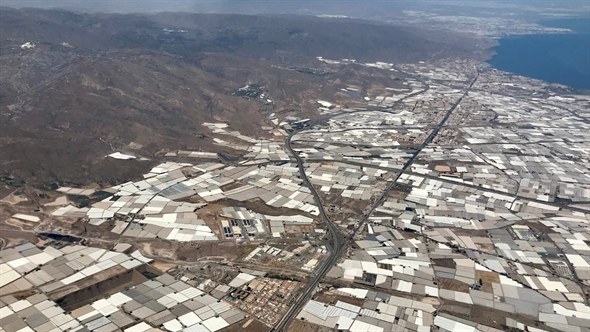PV modules on plastic greenhouses in southern Spain

- Agrivoltaics is the double usage of land for PV installations and agricultural activity
- Solar researcher investigates new way to generate solar power and provide shade for plastic greenhouse cultivation in southern Spain
- PV modules on the roofs of greenhouses could generate sustainable electricity and at the same time protect the plants beneath them from too intense sunlight
- The greenhouse, the PV yield and the growing conditions are simulated using software and the results are checked against real data from the greenhouse
- The results should be transferable to different types of greenhouses
For the past few months, Agrivoltaic doctoral student Anna Kujawa has been spending part of her working time at an unusual workplace for the solar researcher and physicist: in a plastic greenhouse on the outskirts of Almería (Spain). There, together with the company Anecoop and the Fundación UAL-Anecoop, she is investigating the influence of shading from PV modules on the greenhouse roof on the growth of tomato plants.
DLR has been involved in solar research at the Plataforma Solar de Almería (PSA) of the Spanish research centre CIEMAT since the 1980s. Since 2011, DLR has been represented here by the Institute of Solar Research. DLR's solar research at the PSA focuses on concentrating solar power technologies, quality testing of solar power plant components and systems, solar energy meteorology and agrivoltaics. Anna Kujawa is a PhD student in the agrivoltaics team of the Qualification Department.
Vegetable cultivation in plastic greenhouses is the most important economic sector in the Almería region. The climatic conditions with plenty of sunshine are ideal and there is sufficient agricultural land. Cultivation in greenhouses allows farmers to grow plants that require a lot of water, even with the little groundwater available. There is more than enough sunshine here, as the south of Spain is one of the hottest and driest regions in Europe. For large parts of the year, the sunlight is so intense that the farmers sometimes paint the plastic roofs with lime paint to protect the plants from the sun and the high temperatures inside the greenhouses.

DLR
A checkerboard pattern of plastic modules for shading
In order to create shading in the greenhouse similar to that of PV modules, the researcher mounted black, opaque plastic sheets on the roof. The plastic cover is reinforced by metal cross struts underneath so that they can be walked on and are also stable enough to support lightweight PV modules. Anna Kujawa divided the greenhouse into three zones, above which the black panels are laid in a checkerboard pattern, so that the shading varies from zone to zone. Sensors placed in the greenhouse measure how much light reaches the plants in the three zones.
Software simulates plant growth and PV power generation
A central part of her dissertation is an agrivoltaic simulation software developed by Anna Kujawa with an exact virtual copy of the greenhouse. The software can now be validated using the data from the greenhouse. It is also possible to investigate the shade conditions under which the tomato plants develop best and the amount of shade from which the plant suffers. It will also be possible to calculate how much electricity can ultimately be generated by the PV modules. Anna Kujawa wants to make a difference with her dissertation: "Since working on the simulation software, I've learned an incredible amount about the influence of sun and light on plant growth. I find it totally exciting to combine knowledge from different disciplines in order to develop something completely new with a very concrete benefit for agriculture here on site."

DLR
Measuring light incidence and plant growth in the greenhouse
The fact that they can use the Fundación UAL-Anecoop greenhouse is a great stroke of luck for Kujawa and the Agrivoltaic team at the Institute of Solar Research. For the first time, they can not only simulate the shading effects, but also record the real values in the greenhouse and test the simulated effects in practice.
The greenhouse belongs to the Fundacíon UAL-Anecoop, a research collaboration between the University of Almeria and the company Anecoop. The experiment is being carried out in collaboration between these research institutions and DLR. While the DLR team measures and simulates the irradiation in the three differently shaded zones, the tomato plants are provided by the agricultural cooperative Anecoop. Anecoop's agricultural technicians are investigating how some of the plants develop in the zones during the ripening process as well as at the end of the ripening period.
After the tomatoes, cucurbits will be brought into the greenhouse and Anna Kujawa will again measure the amount of light and simulate the influence of light and shade on the growth of the plants. The greenhouse will therefore remain her part-time workplace for quite some time.
